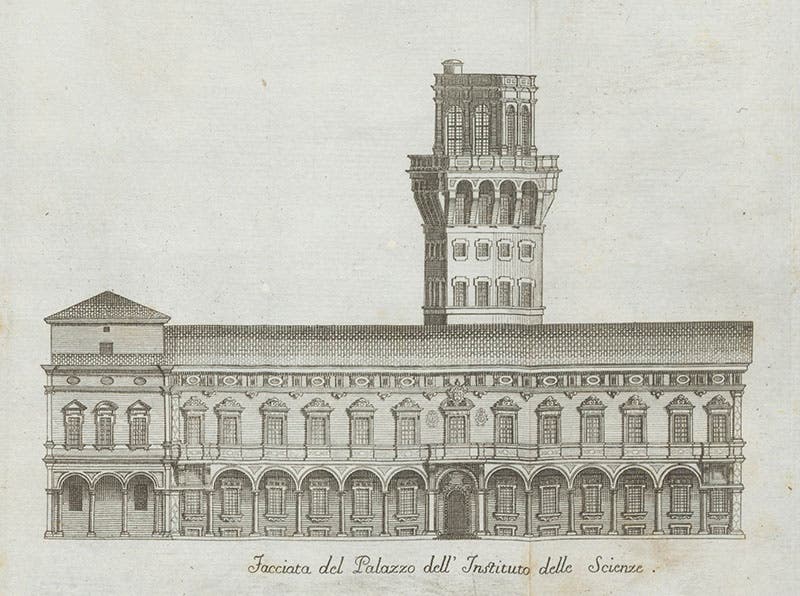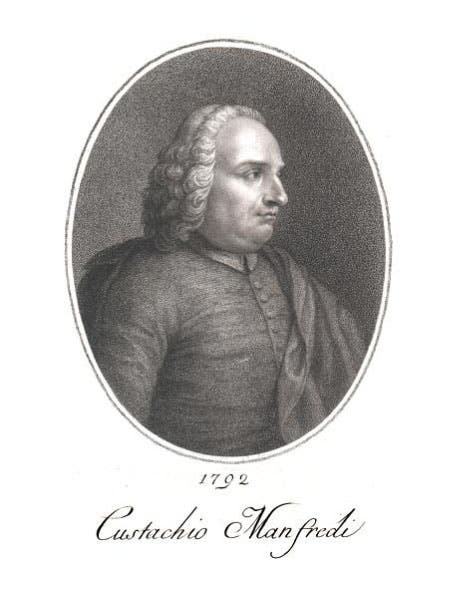Scientist of the Day - Eustachio Manfredi
Eustachio Manfredi, an Italian astronomer, was born Sep. 20, 1674. In the 1690s, Manfredi founded a scientific academy that met at his house. In 1705, the group was invited to meet at the palazzo of Count Luigi Ferdinando Marsili, a wealthy Bolognese naturalist and collector. Manfredi was allowed to use a tower of the palace as an astronomical observatory. In 1711, Marsili (formerly often spelled Marsigli) decided that he wanted to give his collections to the city of Bologna, if they would build an Institute of Science to house them. He also wanted to attach an astronomical observatory to the Institute as a home for his friend Manfredi.
Since Bologna at the time was jointly ruled by the city fathers and the Papacy, Marsigli got the idea of commissioning some astronomical paintings, which he would then give to the Pope, Clement XI. The paintings would show Marsili's astronomical instruments in use, observing the planets, and Marsili would then ask Clement XI to donate funds to build the Institute and the observatory. Manfredi was chosen to advise the painter, Donato Creti, and show him what the planets looked like through a telescope. The 8 paintings, depicting 5 planets, Sun, Moon, a comet, and the instruments used to observe them, were finished in 1711 and presented to Pope Clement XI. We see four of them above; you can see all 8 of them at the Vatican Museums website.
Clement was well pleased with the gift and agreed to fully fund the Institute of the Sciences in Bologna, which was completed in 1725, taking over what used to be the Palazzo Poggi. The associated observatory was finished in 1726, and from his new digs and with Marsili’s instruments, Manfredi could proceed to make his major discovery, the aberration of light.
The aberration of light is a slight displacement in the position of a star, caused by the fact that light takes a finite time to travel from the star, and during this travel time, the Earth changes its position. It is a similar kind of an effect to stellar parallax, but with quite a different cause. Stellar parallax is a very minute effect and would not be observed until 1838. Aberration amounts to about 20 minutes of arc, much larger than parallax, and Manfredi was one of the first to observe it and realize it was not the effect of parallax. Unfortunately, he lived in an Italy in which the Earth did not move, making it very difficult to explain aberration. Manfredi announced his discovery of the effects of aberration in 1729, in a book called De annuis inerrantium stellarum aberrationibus (On the Annual Aberration of the Fixed Stars), but without discussing the Earth’s motion. Before his book was published, James Bradley of England, who had no qualms about a moving Earth, announced the discovery of aberration and its implications – the Earth does move. This was the first evidence that the Earth orbits the Sun. Since Manfredi was unable – and apparently unwilling – to draw that conclusion, he is seldom mentioned as a co-discoverer of the aberration of light, although he surely merits some mention.
We have four books by Manfredi in our collection, including his 1729 work on aberration (eighth image). We also have a slim volume by Giuseppe Bolletti titled The Origin and Progress of the Institute of Science of Bologna (1763), where we find two fold-out engravings of the Institute and its Specola (observatory) (fifth and sixth images). We do not have a portrait of Manfredi, so we borrowed from the excellent portrait collection at the Smithsonian Libraries (seventh image).
Many of the instruments owned by Marsili and used by Manfredi survive and are still on display at the Museo della Specola in Bologna (ninth image). Dr. William B. Ashworth, Jr., Consultant for the History of Science, Linda Hall Library and Associate Professor emeritus, Department of History, University of Missouri-Kansas City. Comments or corrections are welcome; please direct to ashworthw@umkc.edu.












